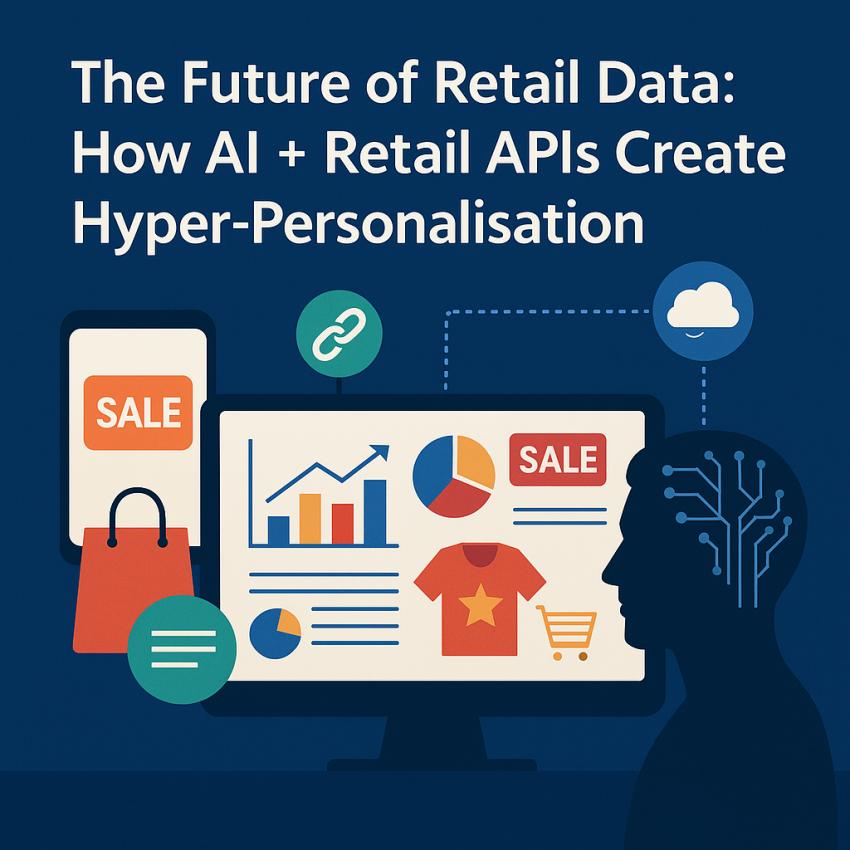
In today’s competitive retail world, data is no longer just an asset — it’s the lifeblood of customer experience. Every click, search, and purchase creates data. The real challenge isn’t collecting it; it’s using it intelligently to deliver what shoppers truly want.
That’s where Artificial Intelligence (AI) and Retail APIs come together — to create hyper-personalised shopping journeys that feel tailor-made for every individual customer.
How Retail APIs Are Transforming Data Collection
A decade ago, retailers relied on spreadsheets, manual research, and guesswork to understand their customers. But in 2025, that’s no longer enough. Modern retailers depend on Retail APIs — powerful connectors that pull real-time data from multiple platforms such as product listings, inventory, and competitor prices.
With Enterprise Web Scraping, companies can now gather millions of data points in seconds from marketplaces, grocery chains, and fashion sites worldwide. These structured APIs automate the entire process — from product data extraction to analytics integration — allowing teams to focus on strategy rather than repetitive tasks.
The result? 99.9% accurate, real-time retail data that empowers smarter decisions and faster market responses.
How AI Turns Retail Data into Intelligent Insights
Collecting data is one thing; understanding it is another. AI bridges this gap by analyzing patterns that humans might miss.
Using machine learning models, retailers can:
Predict which products will trend next month.
Identify which customer segments are most likely to buy again.
Optimize pricing dynamically based on market behavior.
For instance, a brand can use Product Data Scraping to gather SKU-level data from hundreds of e-commerce stores. AI then studies these product attributes — price changes, descriptions, customer reviews — to recommend the most profitable assortment strategy.
It’s not guesswork anymore; it’s data-driven personalisation at scale.
What Is Hyper-Personalisation — and Why It Matters
Traditional personalisation might show everyone in the same age group similar product recommendations. Hyper-personalisation takes this several steps further.
It blends real-time API data (like inventory, pricing, and browsing behavior) with AI analytics (like intent prediction and emotional sentiment) to deliver truly one-to-one experiences.
Examples include:
Dynamic website layouts based on user history.
Tailored discount codes matching customer lifetime value.
Product recommendations that adapt in real time.
Retailers using AI + API-driven data pipelines are seeing up to 20–30% higher engagement rates and 40% faster conversions compared to traditional approaches.
Personalisation in Pricing: The Power of Retail Intelligence
Pricing is one of the most influential levers in retail strategy. With the right data, retailers can predict when and where to adjust prices for maximum profit.
That’s why businesses rely on Retail Pricing Intelligence solutions. These systems combine web scraping, competitor analysis, and AI forecasting to:
Monitor competitor pricing across thousands of SKUs in real time.
Identify margin opportunities instantly.
Detect market anomalies (like flash sales or price drops).
AI doesn’t just track numbers — it learns. It identifies patterns and alerts teams when a competitor is likely to make a pricing move before it even happens. That’s the future of proactive retail.
The Mobile Revolution: Insights from App-Based Data
Mobile shopping has become the center of modern retail. From fashion to grocery delivery, apps now dominate consumer interaction.
That’s where Mobile App Scraping comes in. It helps brands extract real-time data directly from retail and delivery apps — including offers, customer reviews, and product availability.
When AI processes this app-level data, it can map customer journeys across devices and platforms. Imagine being able to send personalised push notifications based on real-time inventory, location, and purchase intent.
The fusion of AI and mobile scraping ensures that brands are not just reacting to customer behavior — they’re anticipating it.
Beyond Retail: The Future of Data in Nutrition & Wellness
Personalisation isn’t limited to what customers buy; it extends to how they live. AI is now reshaping the nutrition and wellness industry using retail-style data collection.
With Nutrition Data Scraping, companies can collect ingredient details, dietary preferences, and consumer feedback from food delivery apps and recipe websites.
AI then analyses this data to suggest personalised meal plans or healthier alternatives, improving both lifestyle and engagement. This cross-industry application of retail data proves one thing — personalisation is universal.
Why AI + Retail APIs Are the Future of Retail
The synergy between AI and Retail APIs is transforming every part of the retail ecosystem:
Product Discovery: AI identifies trending SKUs from scraped data faster than manual teams.
Pricing: Real-time competitive pricing keeps profit margins optimized.
Inventory: API data helps predict stockouts and overstock situations.
Marketing: Hyper-personalisation drives better ad ROI and higher CLV.
Customer Experience: Every user sees exactly what they’re likely to buy — in real time.
Simply put, data is the new fuel, and AI is the engine that turns it into growth.
The Road Ahead
By 2026, the global retail analytics market is expected to exceed $18 billion, with AI-driven personalisation leading the charge. Brands that combine real-time data collection with predictive analytics will outperform competitors on every metric — from conversion rates to customer loyalty.
Those still relying on traditional data methods will struggle to keep up with rapidly evolving consumer expectations.
At RetailGators, our mission is to help enterprises unlock the full potential of retail data through automation, AI, and secure APIs. Whether you need high-volume enterprise web scraping, mobile app data feeds, or end-to-end API integration, we provide the infrastructure to keep your business one step ahead.
Conclusion
The future of retail belongs to brands that know their customers better than anyone else. With AI + Retail APIs, that future is already here.
By turning raw data into meaningful insights, retailers can deliver truly personalised shopping experiences that not only increase sales but also strengthen long-term relationships.



